Descripción del proyecto
Con base en la convocatoria para ‘Walking Art / Walking Aesthetics’ he asumido la extensión sugerida de 800 y 3000 palabras como si fuesen pasos al caminar. Decidí recorrer un bosque finlandés, contando cada paso, y documentar así con mi cámara las particulares de lo que me salió al encuentro en el camino. El breve texto que acompaña las fotografías es una reflexión en estilo libre sobre el caminar por un bosque en un día soleado. Las fotografías están organizadas en forma de dípticos y trípticos.
Project Description
[Based on the call for ‘Walking Art / Walking Aesthetics’, I took the suggested extension of 800 to 3000 words as if they were literally walking steps. I decided to wander through a Finnish forest, counting every step, and document with my camera the particularities of what came to meet me along the path. The short text that accompanies these photographs is a free-style reflection about walking through forest in a sunny day. The photographs are organised in forms of diptychs and triptychs.]
*
Grafía de un camino de bosque
Graphy of a forest path
Fotografía y texto por | Photography and Text by Luca Idrobo
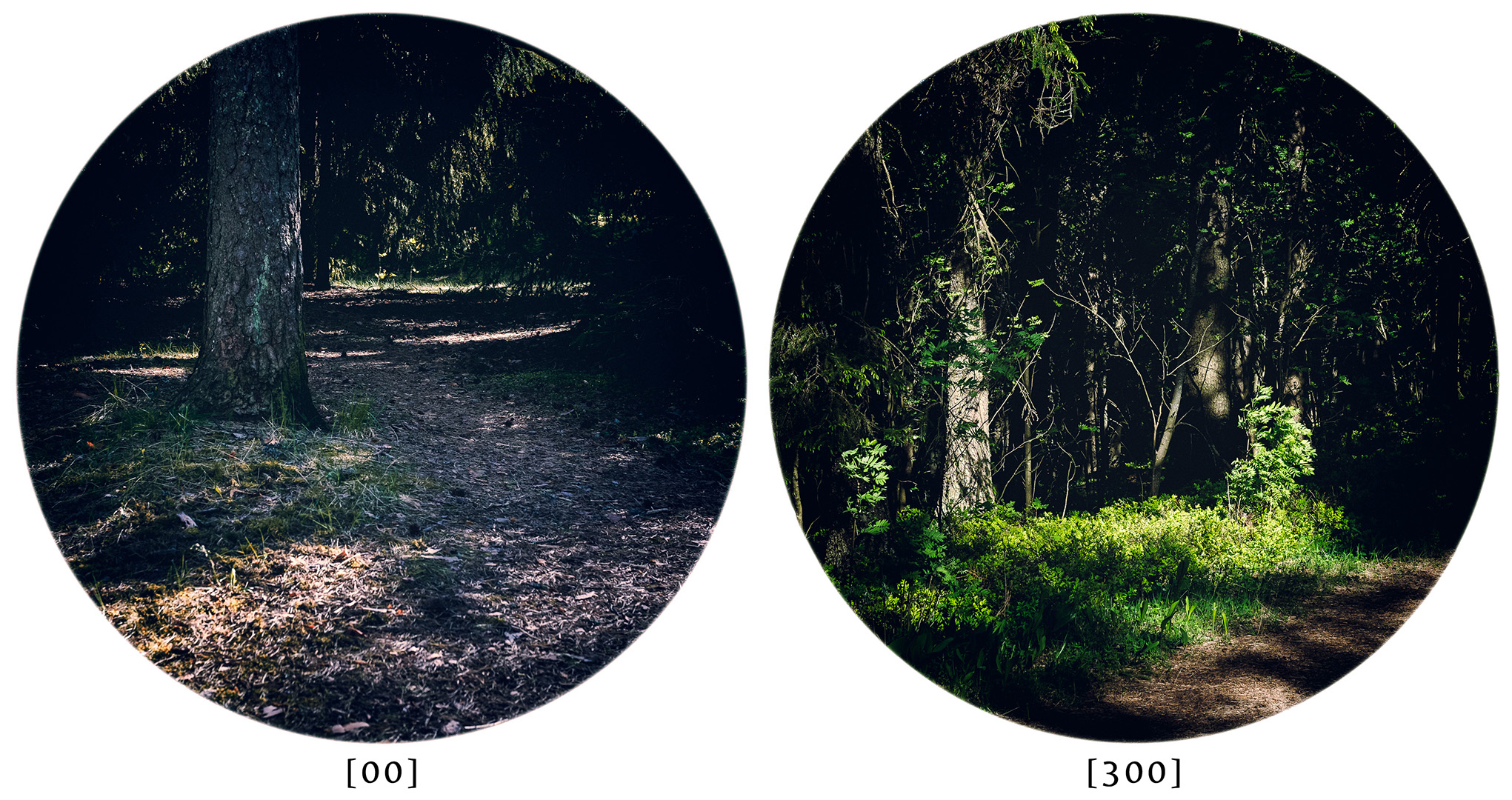
Te dan una medida del camino: en algún punto entre ochocientos y tres mil pasos tu andar ha de terminar. Te paras en el borde donde comienza el bosque [00] y tu destino, cualquiera que sea este, ya está enmarcado por dos límites: uno espacial y fijo, el lugar donde estás ahora, y uno temporal y movible aún por definir, un punto entre ochocientos y tres mil pasos. Entonces das el primero y caminas cuesta arriba.
[They give you the measure of the path: somewhere between eight and three thousand steps your walk must end. You stop at the edge where the forest begins [00] and your destination, whichever this may be, is already framed by two limits: a spatial and fixed one, the place where you are now, and one temporary and movable yet to be defined, a point between eight and three thousand steps. Then you take the first and walk uphill.]

Un poco más adelante te detienes ante una gran roca que parece formar una masa de vida en sí misma y a su alrededor. No hace mucho que vives en una parte del mundo en el que las rocas te llaman con insistencia por primera vez en mucho tiempo. Has vuelto a escucharlas como cuando eras niño. Comprenderás así la fragmentación de las rocas y cómo ellas habitan el suelo y el subsuelo por donde andas. En el último invierno casi todas habían desaparecido bajo la nieve. Pero tu camino apenas empieza. Por eso sigues subiendo y adviertes que la distancia entre cada paso se hace más corta. Abarcas menos. Tu tiempo es más lento pero cadencioso. Cada paso lo haces con cautela, con más esfuerzo.
[A little further on you stop before a large rock that seems to form a mass of life in and around itself. Not long ago you live in a part of the world where rocks call you insistently for the first time in long years. You have heard them again as you did when you were little. You will understand the fragmentation of rocks and how they inhabit the ground and the subsoil where you walk. Last winter, almost all had disappeared under the snow. But your path is just commencing. That is why you keep going upwards and realise that the distance between yours steps becomes shorter. You cover less. Your tempo is slower but rhythmic. Each step you do is more cautious, each step takes more effort.]
Cuando llegas a la cumbre, miras atrás hacia esa masa oscura de la que acabas de salir [300]. Has llegado a la parte más soleada del bosque. Pero enseguida éste te confirma esa extraña connivencia entre muerte y vida, a veces de forma exuberante, a veces con admirable simplicidad: érase una vez un árbol [333] al que se le desprendió una parte de su corteza… érase una vez un caminante que emergió del bosque como el desenvolverse hacia la luz de un joven helecho al lado del camino [628]. Alguna vez un filósofo entendió esto como physis.
[When you reach the summit, you look back at that dark mass from which you just came out [300]. You have reached the sunniest part of the forest. But soon it confirms you that strange connivance between death and life… sometimes exuberantly, sometimes with admirable simplicity: once upon a time there was a tree [333] whose part of its bark fell off ... once upon a time there was a wanderer who emerged from the forest as the young fern on the side of the road unwinding towards the light [628]. Once there was a philosopher who understood this as physis.]
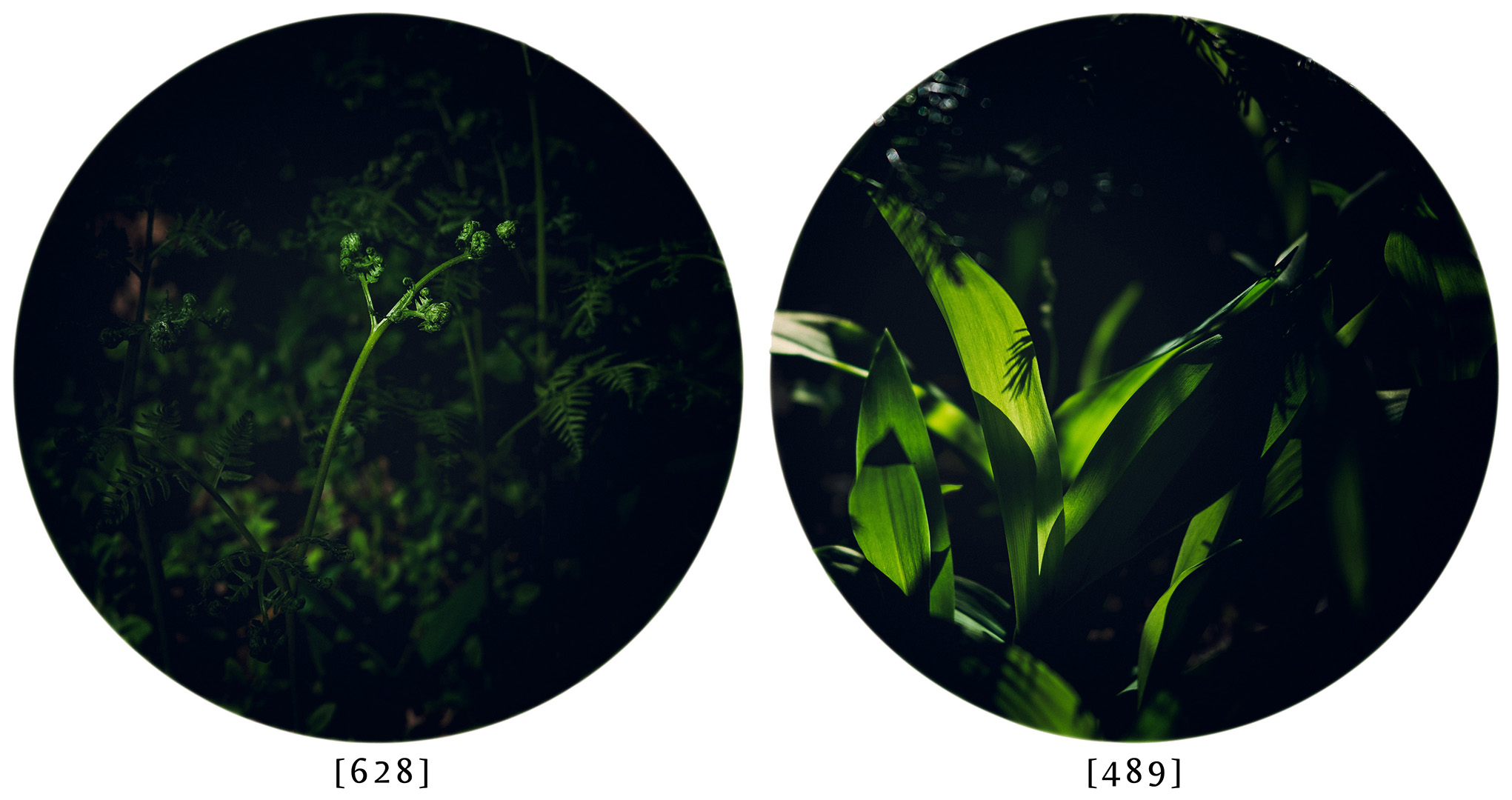
Y ahora vas por el sendero por donde otros han pasado. Tu ritmo se acelera, y con ello aumenta la distancia entre tus pisadas. Sientes el caminar como tal y no te detienes. Pero en este día soleado pronto serás testigo de otro fenómeno que sólo al caminante se le ofrece en su andar: un juego de sombras en el que el bosque se proyecta sobre sí mismo [489]. Esta hoja a tus pies se convierte en la proyección de la otra, y aquella en la de enseguida, y así sucesivamente. En cada claro del bosque, se crea y se recrea un juego de superficies y proyecciones. Desde el momento en el que entraste aquí ya formabas parte de él, aunque no te hubieses dado cuenta. Tu caminar es no es más que un atravesar por un antiquísimo juego que seguirá aconteciendo cuando ya te estés ausente.
[And now you walk the path where others have passed. Your pace accelerates, and with it the increasing distance between your footsteps. You feel the walk as such, you do not stop. But on this sunny day, you will soon witness another phenomenon that is only offered to the wanderers in their walk: a game of shadows in which the forest projects itself. [489] This leaf at your feet becomes the projection of the other, and that of another one, and so on. In each clearing of the forest, a game of surfaces and projections is created and recreated. From the moment you entered here you were already part of it, even if you had not realised it. Your walk is nothing more than the passing through an ancient game that will continue to happen even when you are already absent.]
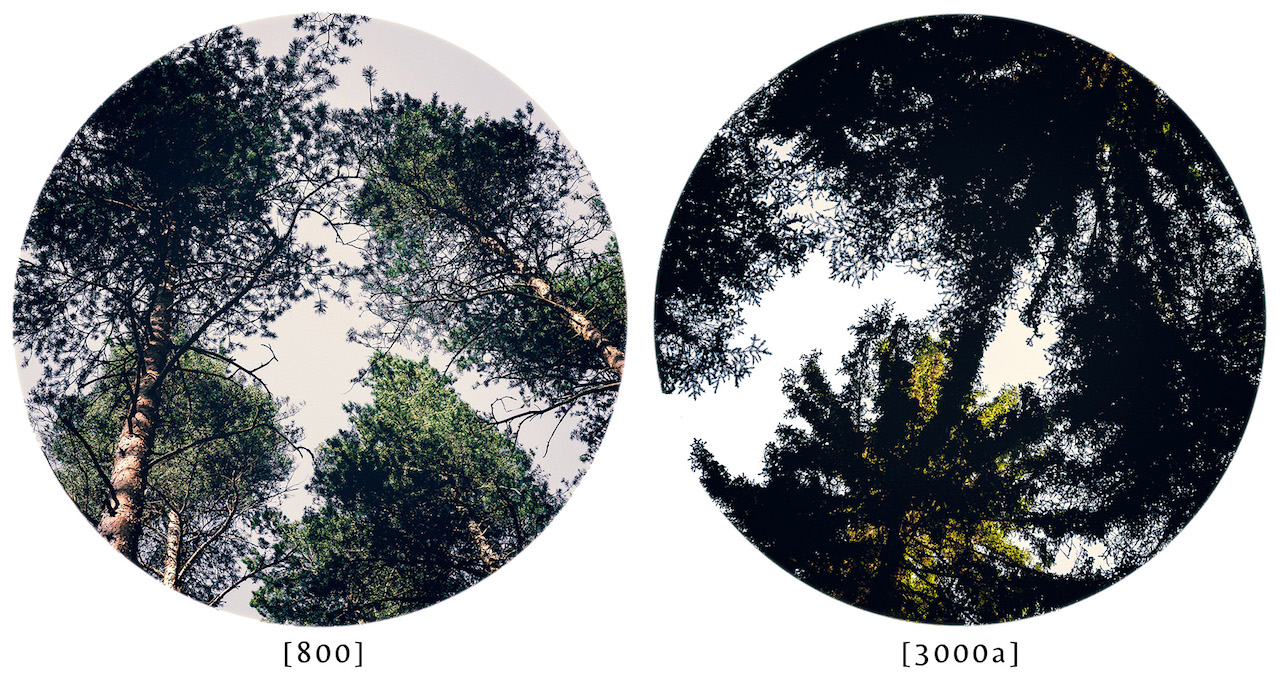
Finalmente llegas al primer límite ya trazado [800]. Has dado ochocientos pasos. Miras a tu alrededor. El sonido del viento eleva tu mirada para contemplar y escuchar los viejos árboles meciéndose. La madera cruje suavemente, como entreabriendo puertas invisibles hacia un reino que sólo los pájaros conocen. Entonces pones un pie delante del otro y sigues adelante, esta vez con la mirada arriba. Sientes así la familiaridad de un paisaje que ya has visto, y te das cuenta de que es posible perderse en la repetición: cada árbol se asemeja al otro y en la multiplicación de su figura se cancelan los puntos de referencia que orientan tu andar. Cada uno se repite, como tus pisadas. En realidad, piensas que podrías andar perpetuamente, que cada pino y cada abedul equivale a cada paso que has dado a lo largo de los años. Pero ni tú ni los bosques se extienden hasta el infinito. Ya otros como tú han superpuesto nuevos juegos sobre el bosque y sobre tu andar, un conjunto de reglas, usos, leyes y signos: el camino del que en invierno nadie se hace cargo, un letrero que te anuncia la distancia faltante hasta cierto lugar, un signo que demarca un sendero de caballos, algunos restos de bandas amarillas de advertencia.
[Finally, you reach the first limit already drawn [800]. You have taken eight hundred steps. You look around. The sound of the wind raises your gaze to contemplate and hear the old swaying trees. The wood creaks softly, as if opening invisible doors into a realm known only to birds. Then you put one foot in front of the other and keep walking, this time with your eyes up. Thus, you feel the familiarity of an already seen landscape, and you know that it is possible to get lost in the repetition: each tree resembles the other and in the multiplication of its figure the reference points that guide your walk are cancelled. Each one repeats itself, like your footsteps. In fact, you may think you could walk perpetually, that each pine and each birch is equal to each step you have taken over the years. But neither you nor the forests extend to infinity. Already others like you have superimposed new games on the forest and on your walk, a set of rules, uses, laws and signs: the path nobody takes charge in winter, a sign telling you how far away certain place is, a sign that marks a horse trail, the remains of yellow warning tapes.]
Hacía poco que estaban talando árboles, pero aún te preguntas por qué algunos de los jóvenes cayeron, como aquel tocón de abedul que alguna vez viste ser engullido poco a poco por un creciente hormiguero. En algún punto entre ochocientos y tres mil pasos, esos cortes de árbol, a veces limpios, a veces imprecisos [2280], te recordarán una mano abierta cuya piel parece agrietarse. Incluso te parece gracioso ese pedazo de tronco [917] perfectamente cortado que aún se erige como si estuviese vivo, pretendiendo ser lo que ya no es.
[Not long ago they were cutting down trees, but you still wonder why some of the young trees fell, like that birch stump you once saw little by little being swallowed up by a growing anthill. At some point between eight and three thousand steps, those tree cuts, sometimes clean, sometimes inaccurate [2280], will remind you of an open hand whose skin seems to crack. Even that piece of perfectly cut log [917] seems funny to you, standing there as it were still alive, pretending to be what it no longer is.]
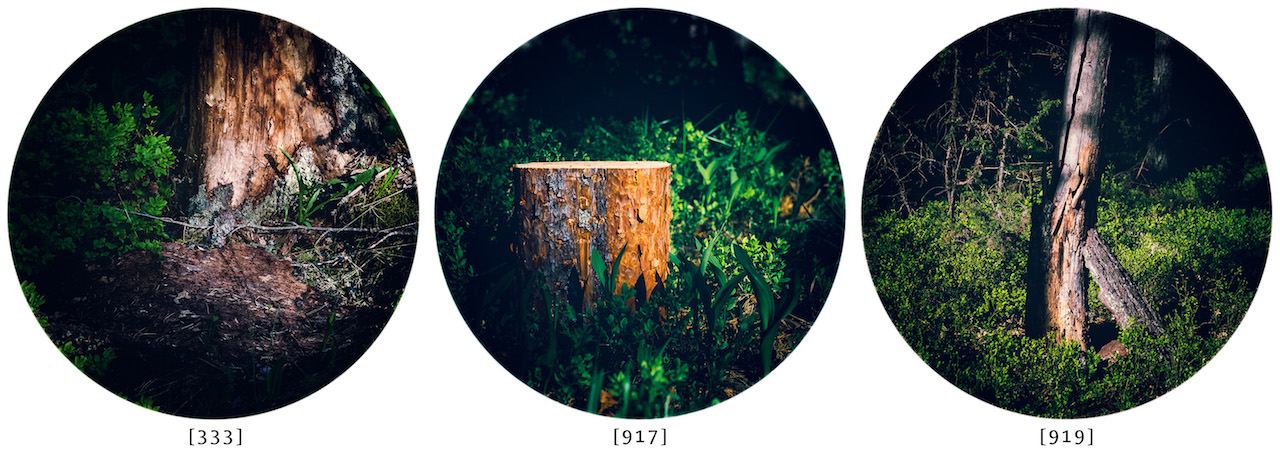
Pero en medio de este gozo, un sonido crujiente te hace dar vuelta y tienes la sensación de que un árbol muerto se te viene encima [919]. Te da miedo y te distancias rápidamente dando dos pasos largos. Pero el árbol sigue ahí. Ni se ha caído y tampoco nadie quiso tumbarlo. ¿Por qué? Esta pregunta acompaña tu andar, mientras tu mirada vuelve sobre el suelo, las rocas, y las raíces abiertas de aquellos árboles que han sufrido el tránsito de máquinas [1582].
[But in the middle of this joy, a crispy sound makes you turn around and you have the feeling that a dead tree is falling over you [919]. It scares you and you quickly take two long steps away. But the tree is still there. Neither has fallen and nobody wanted to knock it down. Why? This question joins your walk, while your gaze turns on the ground, the rocks, and the open roots of those trees that have suffered the transit of machines [1582].]
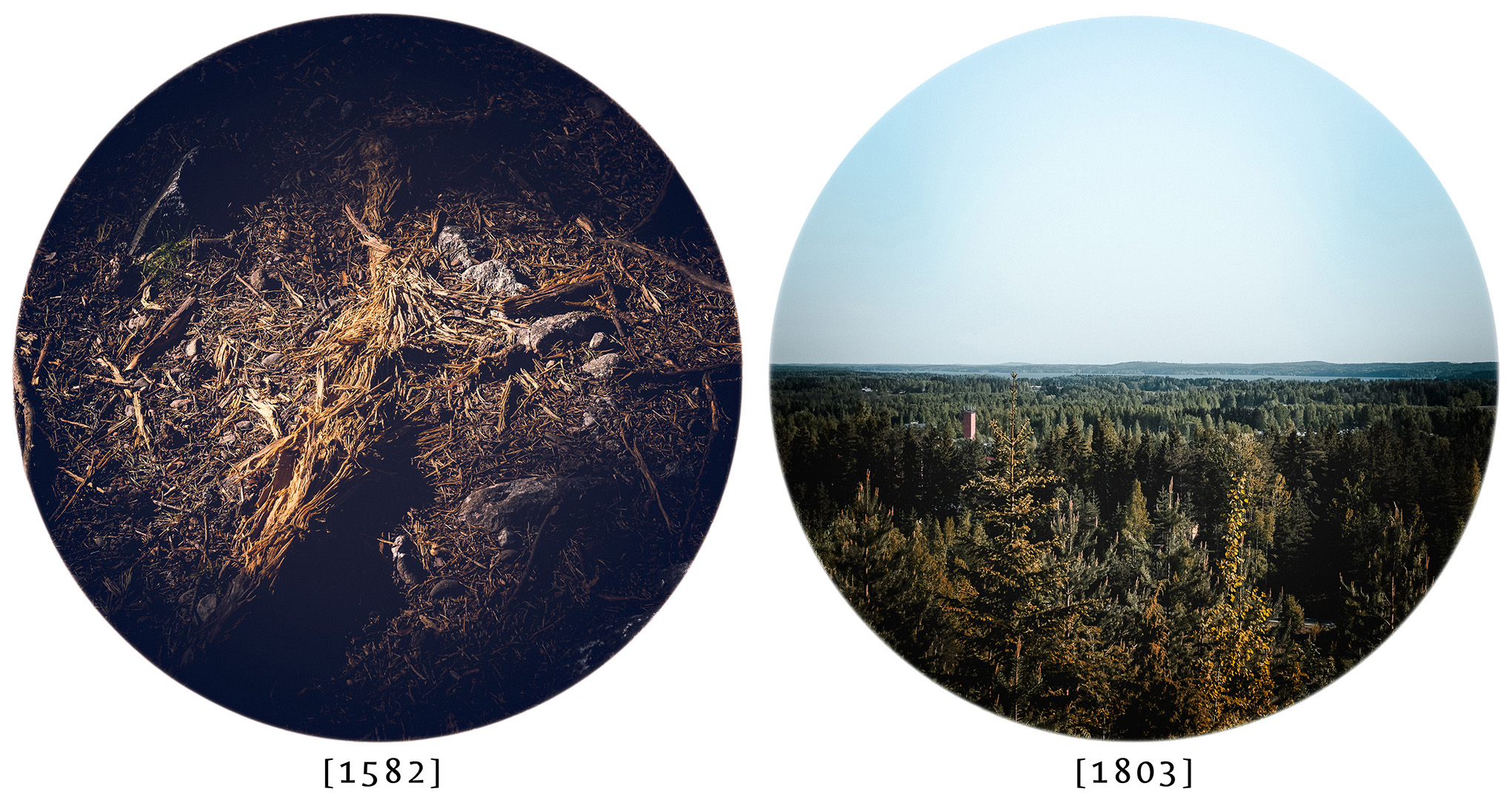
Entonces llegas a uno de los puntos más altos del bosque [1803]. Un lugar donde se abre el paisaje en el que se distiende la humanidad y la naturaleza. Un lugar límite donde el camino supone o bien el regreso o la continuidad por el borde de un precipicio. Pero no quieres retroceder. Ahora el fin de tu camino, previamente trazado a ochocientos pasos, empieza a desplazarse contigo mismo. Bajo tus pisadas arrastras cada vez el final de la marcha.
[Then you arrive at one of the highest points of the forest [1803], a place where the landscape in which humanity and nature unfold. A liminal place where the path tells you either to return or to continue by the edge of a precipice. But you do not want to go back. And now the end of your path, previously traced to eight hundred steps, begins to move with yourself. Under your footsteps you drag every time the end of the march.]
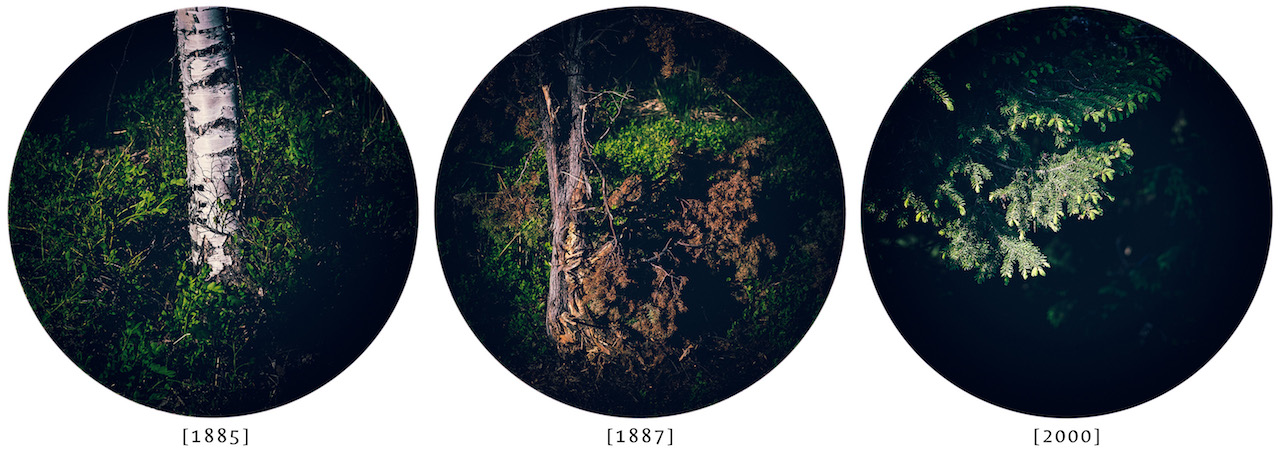
Te encuentras luego con un joven abedul que refleja la luz cual hoja en blanco [1885]. A veces sientes que puedes desaparecer en la contemplación de los abedules. Aunque esta vez, tan sólo dos pasos más adelante, un pino [1887] te sale al encuentro como una figura de Jano, con una cara rejuvenecida y verde que se oculta dándote la espalda, y otra seca con tonos tierra que te da la cara. El bosque siempre te muestra el reverso de sí mismo. Sabrás así que también los pinos rejuvenecen [2000], que en la aparente permanencia de su verdor también hay tiempo para empezar de nuevo.
[Then you meet a young birch tree that reflects light like a blank page [1885]. Sometimes you feel that you can disappear in the contemplation of the birch trees. Although this time, just two steps ahead, a pine [1887] greets you like a Janus figure, with a rejuvenated green side that hides itself by turning its back on you, and another dry with earth tones that faces you. The forest always shows you the reverse of itself. You will know that pine trees also rejuvenate [2000], that in the apparent permanence of their evergreen façade there is also time to start over.]
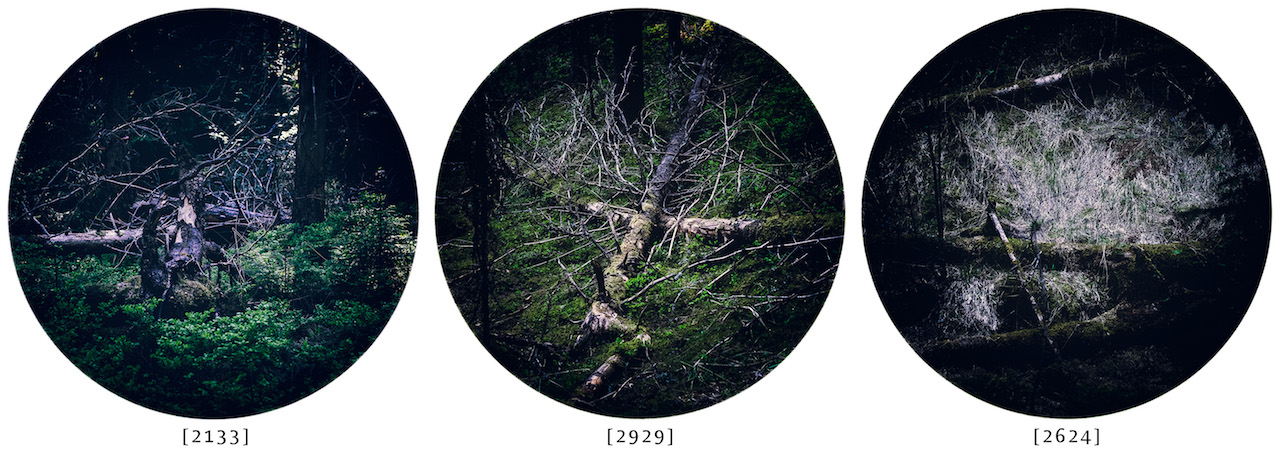
A partir de aquí tu caminar estará guiado por la expectativa de un final inevitable cuando completes los tres mil pasos. A partir de aquí sabes que te adentras en lo profundo del bosque, donde otro clima te abraza y la luz escasea, donde ves un árbol caído cuya corteza ha asumido el color de la noche [2133]. Has visto y seguirás viendo tantos árboles caídos [2929] que comprenderás cómo el bosque también ofrece líneas horizontales que se atraviesan y comprimen el paisaje [2624]. En un primer momento experimentas esto como obstáculos para sortear, a veces pasando por debajo, a veces por encima.
[From here on your walk will be guided by the expectation of an inevitable end when you complete the three thousand steps. From here on you know you are going deep into the forest, where another climate embraces you and light is scarce, where you see a fallen tree whose bark has assumed the colour of the night [2133]. You have seen and will keep seeing so many fallen trees [2929] that you will understand how the forest also offers horizontal lines that cross and compress the landscape [2624]. At first, you experience this as obstacles to overcome, sometimes going under, sometimes over.]
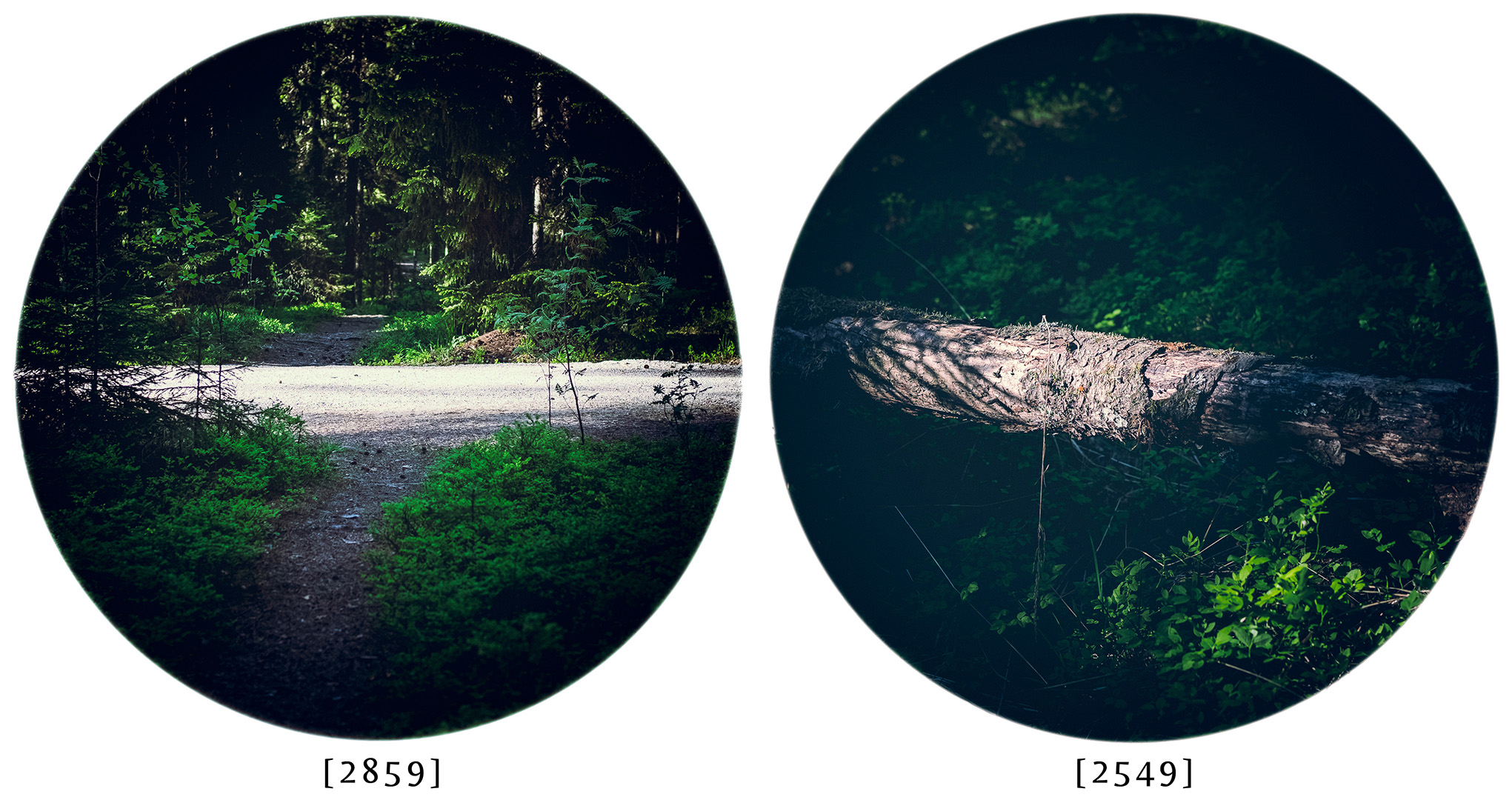
Sin embargo, justo cuando tienes la oportunidad de salir de esta oscuridad, te detienes para observar un camino de piedras iluminado por el sol [2859], y recuerdas aquel árbol que, unos pasos atrás, se extendía frente a tus ojos como un puente iluminado [2549]. Piensas que, para el insecto, aquel árbol no es más que una conexión entre dos extremos oscuros. Entonces regresas a lo profundo del bosque y te das cuenta de que, en una de sus fases del morir, los árboles, cuando yacen extendidos, se vuelven en superficie del andar. Te subes a uno y das pasos de equilibrista. En eso te pareces al insecto, para quien trepar no es más que un caminar contra la gravedad. Y ahora que estás tan cerca del final sabes que todo este tiempo has caminado sobre sombras de árboles y arbustos [2869]. Has sido un funambulista avanzando sobre la superficie en la que el bosque mismo se desenvuelve y se repliega.
[Yet, just when you have the opportunity to get out of this darkness, you stop to observe a stony path lit by the sun [2859], and remember that a few steps back a fallen tree stretched before your eyes like an illuminated bridge [2549]. You think that, for the insect, that tree is only a connection between two dark extremes. Then you return to the depths of the forest and you realise that, in one of their phases of dying, spread out laying trees become a surface for walking. You get on one and take steps like a tightrope walker. In that you resemble the insect, for whom climbing is nothing more than a walk against gravity. And now that you are so close to the end you know that all this time you have walked over shadows of trees and bushes [2869]. You have been a tightrope walker advancing on the surface on which the forest unfolds and folds over upon itself.]
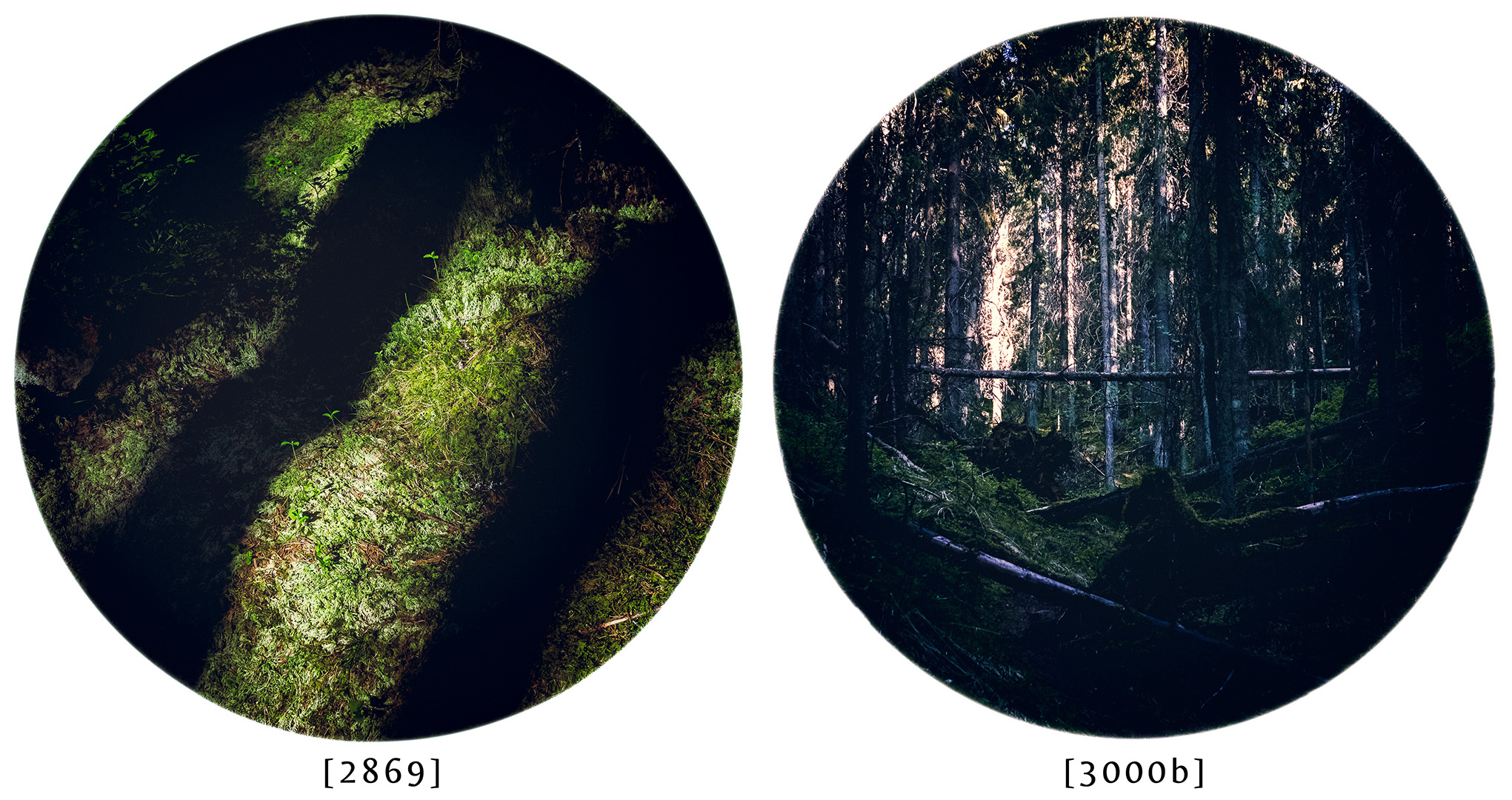
Llegas finalmente hasta el borde que te han trazado [3000a]. Hasta aquí has dado tres mil pasos y levantas tu mirada. Estos enormes árboles que te rodean con sus ramas te plantean un entrelazado de caminos que se bifurcan y por los que uno a uno tus ojos se pierden. Y al volver la vista atrás [3000b] el bosque se te presenta como una masa inextricable de sombras cambiantes. En esta simple exuberancia que juega con sí misma una pregunta te sale al encuentro: ¿qué pasaría si tu partida fuese como la de los árboles? Caminarás hasta el lugar en el que se decide tu reposo. Te quedarás ahí acostado, sentado o parado, y tu cuerpo mismo será un mausoleo frente al que otros pasearían, o un espacio para las plantas que aún no emergen, o una superficie sobre la que caminarán insectos o animales de bosque, o quizás un lugar de paso para los pájaros y las sombras. Ahora mismo eres una sombra andante de bosque. Ahora mismo, aunque no lo adviertas, fragmentos de ti se precipitan lentamente hacia la ausencia.
[You finally reach the limit that has been drawn for you [3000a]. Up to this point you have taken three thousand steps and you raise your gaze. These huge trees surrounding you with their branches pose a weave of forking paths through which one by one your eyes get lost. And as we look back [3000b] the forest appears to you as an inextricable mass of everchanging shadows. In this simple exuberance that plays with itself, a question comes up to you: what would happen if your death were like the one of trees? You will walk to the place where your rest is decided. You will lie there, sitting or standing, and your body itself will be a mausoleum in front of which others would walk by, or a space for plants that have not yet emerged, or a surface on which insects or forest animals will walk on, or perhaps a place of passage for birds and shadows. At this very moment, you are a walking shadow of the forest. At his very moment, even if you do not notice it, fragments of you precipitate slowly into absence.]
__
Carlos Idrobo (*1979 Colombia) es psicólogo, filósofo y doctor en historia del arte de la Universität Greifswald (Alemania), con una disertación sobre la figura del caminante en el arte alemán del siglo XIX. Bajo el pseudónimo ‘Luca Idrobo’ también se dedica a la fotografía artística. Actualmente vive en Finlandia y es investigador afiliado a la Universidad de Turku.
[Carlos Idrobo (*1979 Colombia) is a Psychologist, Philosopher, and PhD in Art History of the Universität Greifswald (Germany), with a dissertation on the motif of the wanderer in the German art of the nineteenth-century. Under the pseudonym ‘Luca Idrobo’ he also devotes himself to fine art photography. Currently, he lives in Finland and is an affiliated researcher at the University of Turku.]
*

